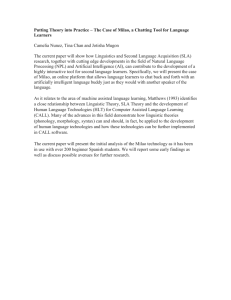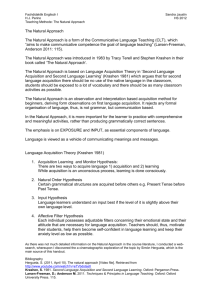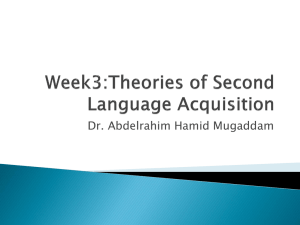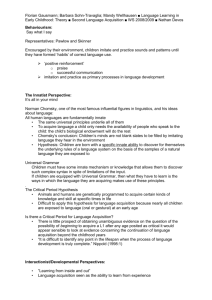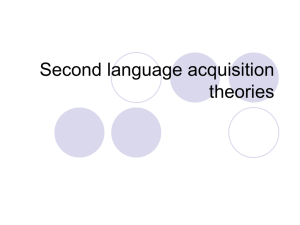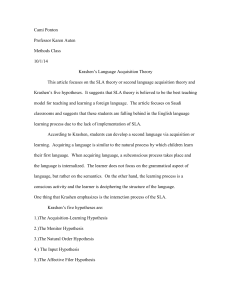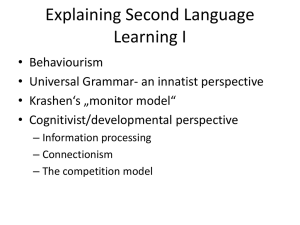Second Language Acquisition
advertisement
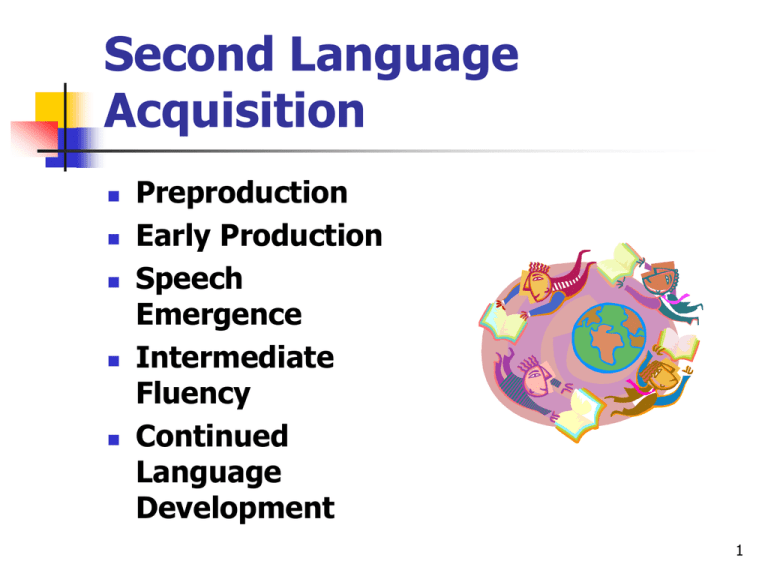
Second Language Acquisition Preproduction Early Production Speech Emergence Intermediate Fluency Continued Language Development 1 Second Language Acquisition The process of language acquisition is lengthy. Students move through five stages while developing English language proficiency. 2 Preproduction Students observe and internalize the new language. They use gestures, pointing and nodding to communicate. 3 Early Production Students continue to acquire English and they use language patterns, yes/no responses and single words to communicate. 4 Speech Emergence Students begin to use simple sentences. At this stage they may begin to initiate discussion. 5 Intermediate Fluency Students are fairly comfortable in social language situations. They state opinions and ask for clarification. 6 Continued Language Development Students participate in classroom activities with additional support for comprehension, academic language and cultural information. 7 Factors that determine progression Prior knowledge Cultural background Reason for immigration Personality Previous schooling Literacy in first language Proficiency in first language 8 Silent Period In the first months, children will go through a “silent period” where they may not produce language but will be listening and internalizing English language structure. 9 Silent Period (cont’d) With some students this may be for a period of 2 to 6 months. The main characteristic of the Silent Period is that after some initial exposure to the language, the learner is able to understand much more than s/he can produce. 10 What the research says: Research shows that children learn social language skills much sooner than the academic language skills. Although children may seem at first not to understand what is going on in the classroom, they are actually transferring concepts and language structure. 11 Krashen’s Theory of Second Language Acquisition Acquisition-Learning hypothesis Monitor hypothesis Natural Order hypothesis Input hypothesis Affective Filter hypothesis 12 Acquisition-Learning Acquisition is the product of a subconscious process very similar to the process children go through when they acquire their first language. Learning is the product of formal instruction and it comprises a conscious process which results in conscious knowledge ‘about’ the language. 13 Monitor Monitor explains the relationship between acquisition and learning and defines the influence of the latter on the former. The monitor acts in a planning, editing and correcting function. 14 Natural Order Natural Order is based on research findings (Dulay & Burt, 1974) which suggested that the acquisition of grammatical structures follows a natural order which is predictable. 15 Input Input explains how the learner acquires a second language. The learner improves and progresses along the “natural order” when s/he receives second language “input” that is one step beyond her/his current stage of linguistic competence. 16 i+1 Students receive second language 'input' that is one step beyond his/her current stage of linguistic competence. For example, if a learner is at a stage 'i', then acquisition takes place when he/she is exposed to 'Comprehensible Input' that belongs to level 'i + 1'. 17 Affective Filter Embodies Krashen’s view that a number of ‘affective variables” play a facilitative, but non-causal, role in second language acquisition. These variables include: motivation, self-confidence and anxiety. Learners with high motivation, self confidence, a good self-image, and a low level of anxiety are better equipped for success in SLA. Low motivation, low self-esteem, and debilitating anxiety can combine to ‘raise’ the affective filter and form a ‘mental block’ that prevents comprehensible input from being used for acquisition. 18


